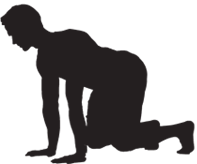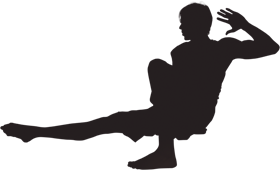
Understanding the 6 Components of Animal Flow
When founder Mike Fitch first started creating Animal Flow, he brought with him a wealth of fitness experience and an obsession with gathering more knowledge to better serve his clients. Informed by over a decade of coaching and personal training, he knew the power of building a foundation and creating systems that would allow his clients to progressively excel.
This experience served him well as he continued to shape the AF curriculum in addition to observing how people, trainers, and coaches were applying the program within their own practice and that of their clients. It was clear that the system needed to be sophisticated to meet the needs of the human body, but also as simple as possible for ease of both learning and application. It was important to him that anyone could come into the system and feel successful at it right away, though if they chose to get deeper into it, it would also allow for that.
This ultimately led to the development of a range of movements and combinations grouped into categories Mike later named the “Six Components”. Each Component is designed to elicit specific results and can be mixed and matched in many ways, allowing the user to incorporate one, some, or all of them in their workouts and programs.
THE SIX COMPONENTS OF ANIMAL FLOW

WRIST MOBILIZATIONS
What Is It
Wrist Mobilizations are simple, yet effective movements used to prepare the hands and wrists for the challenges of Animal Flow. Healthy wrists are incredibly important to the success of both novice and experienced Flowists, which is why it’s always our first component.
The Story
Mike: When I first started introducing the Animal Flow movements to my clients, I recognized right away that their wrists were typically the first area to fatigue. Most people have very little experience exercising with both hands and feet in contact with the ground which can make the beginning of an Animal Flow practice slightly uncomfortable. The truth is, the wrists will adapt to the new loads being placed on them, especially if we put forth extra effort to keeping them mobile. We always encourage wrist “mobs” before, during and after any AF practice as addressing this area will dictate the rate of comfort and success within the system.

ACTIVATIONS
What Is It
Activations are a way of “waking up” the body and encouraging it to communicate. The Animal Flow practice uses two activation positions, Beast and Crab, which are two of the four base positions in the AF system. Activations are isometric holds that are systematically progressed by decreasing the points of contact with the ground. For example, we can start with both the hands and feet on the floor (4 contact points), and then progress to lifting one foot or one hand at a time (3 contact points), and end with the opposite hand and foot lifting at once (2 contact points).
The Story
Mike: In the early stages of Animal Flow, I was constantly looking for ways to use quadrupedal positions to load the entire body as a “global” integrated unit, versus the traditional approach of isolating muscles and joints.
With that said, the Beast and Crab activations are perfect compliments to each other from an anatomical perspective: Holding these positions, introduces a truly unique challenge for the lines of muscle congruencies on the front and back side of the body that run vertically from head to toes and from each shoulder to its opposite hip. These “slings and chains” of tissue are commonly known as flexion/extension chains and anterior/posterior oblique slings. With so much opportunity to engage large areas of muscles, we see the activations as ideal tools to prime the body before movement, whether it be AF or anything else.
Activations are also an excellent opportunity to gently invite conscious awareness back into one’s body. In today’s world, so many things are competing for our attention which can lead to a disconnection of body and mind. Simply by placing our hands and feet in contact with the ground to perform these seemingly easy tasks, it becomes very difficult to think about anything else that’s happening around us or in our lives.

FORM SPECIFIC STRETCHES
What Is It
Form Specific Stretches are full body mobilizations that begin in one of our four base positions, then move through various ranges of motion. The goal of each FSS is to encourage a combination of flexibility and stability (i.e. mobility) through the body’s many articulations.
The Story
Mike: To be completely honest, if I were able to go back in time, I would rename these movements Base Specific Mobilizations as the word stretch is a bit misleading. At the time of creating the system, stretching and or flexibility were far more recognizable words than mobility and they inevitably bring up images of passive holds or static positions. Fast forward to today, and I can confidently say that not only are the Form Specific Stretches anything other than passive, but more people are now aware of the value of mobility. In fact, we’ve come to see these variations not only as opportunities to create better mobility but also as strength training movements within the AF system.
Performing each movement slowly is an excellent way to identify and condition strength gaps that you may have within the pattern. However, like many of the other movements with variable applications, we can also perform the FSSs at varied speeds within our Flows.

TRAVELING FORMS
What Is It
Traveling forms are the animal locomotive movements of Animal Flow. In the Level 1 workshops we teach the ABCs of animal movements: Ape, Beast, Crab, along with their variations.
The Story
Mike: It’s common for most people to hear the name Animal Flow and assume that the practice must be all about acting like animals. The irony is that the usage of the word animal is actually referring to the “human animal”. Yes, we do use animal locomotion, but the Ape, Beast and Crab traveling forms were chosen and altered to illicit specific results within the human body and to complement our bipedal form.
I was first introduced to animal locomotion during Parkour practice, where the instructor was using various travels as a warmup. I immediately recognized the power and versatility of such movements and saw multiple applications, ranging from rehabilitation to performance. Personally, I love using traveling forms for my cardiovascular conditioning or in my flows as a stylistic way to morph in and out of an animal form.

SWITCHES & TRANSITIONS
What Is It
The Switches and Transitions (S&Ts) make up the bulk of the “flow” in AF practice. These are dynamic movements that can be linked together to form endless combinations or can stand alone as a powerful exercise or drill.
The Story
Mike: The Animal Flow S&Ts were highly inspired by an element of breaking (breakdancing) known as footwork. If you’re not familiar with breaking terminology, you can think of footwork as ground maneuvers that are mostly quadrupedal meaning hands and feet are in contact with the ground. It was through the practice of footwork that I started to see how one movement could unlock the potential for a seamless transfer into a follow up movement. In Animal Flow we refer to these possibilities as “movement windows”. For example, if I’ve created a window while in contact with the ground, I could potentially move through it, over it or under it.
Our foundational Switches & Transitions are broken down into four categories: Underswitch, Side Kickthrough, Scorpion, Front Kickthrough and each of their variations. Even with just a few basic Switches & Transitions, the potential combinations of movements are endless.

FLOWS
What Is It
Flows are where all of the Animal Flow components come together. Flows can be performed in many ways, but there are 3 main styles: Choreographed, Freestyle Call Outs, and Free Flow.
The Story
Mike: It was the feeling of Flow that hooked me from the very beginning of my journey into free movement. This sensation was a huge catalyst for creating a practice that systematically prepared the participant for higher levels of Flow. I wanted to provide building blocks that one could use to create and explore with. The three styles of Flow: Choreographed, Freestyle Call Outs, and Free Flow are perfect examples of how Flow can be practiced in different ways.
Choreographed Flows are predesigned sequences that are seen as the “performance” of Animal Flow. These sequences are used for practice with the intention of becoming more fluid or to find opportunity for tempo changes and stylistic expression. Choreographed Flows can be practiced alone or in groups of any size.
The Freestyle Call Outs are all about reaction time and finding Flow with the person who is calling out to you. This is where the understanding of the AF language is essential to reaching higher levels of Flow.
Freestyle Flows, in my opinion, are the pinnacle of Animal Flow. At this point we’re practiced enough with the system that we can choose to stop thinking about what movement is coming next and just feel where our body wants to go.
For more info about Flow, check out “Becoming a Flowist”.
COMMUNITY
Mike: Although not one of the components, I’d be remiss not to mention the incredible community that utilizes this 6 component system in endless ways not just to improve their human function but to connect to others through the shared language of movement. We have a global group of instructors inviting others back into their bodies with any or all of the components of AF which fulfills the original intention of this system in ways I couldn’t have imagined 10 years ago.
